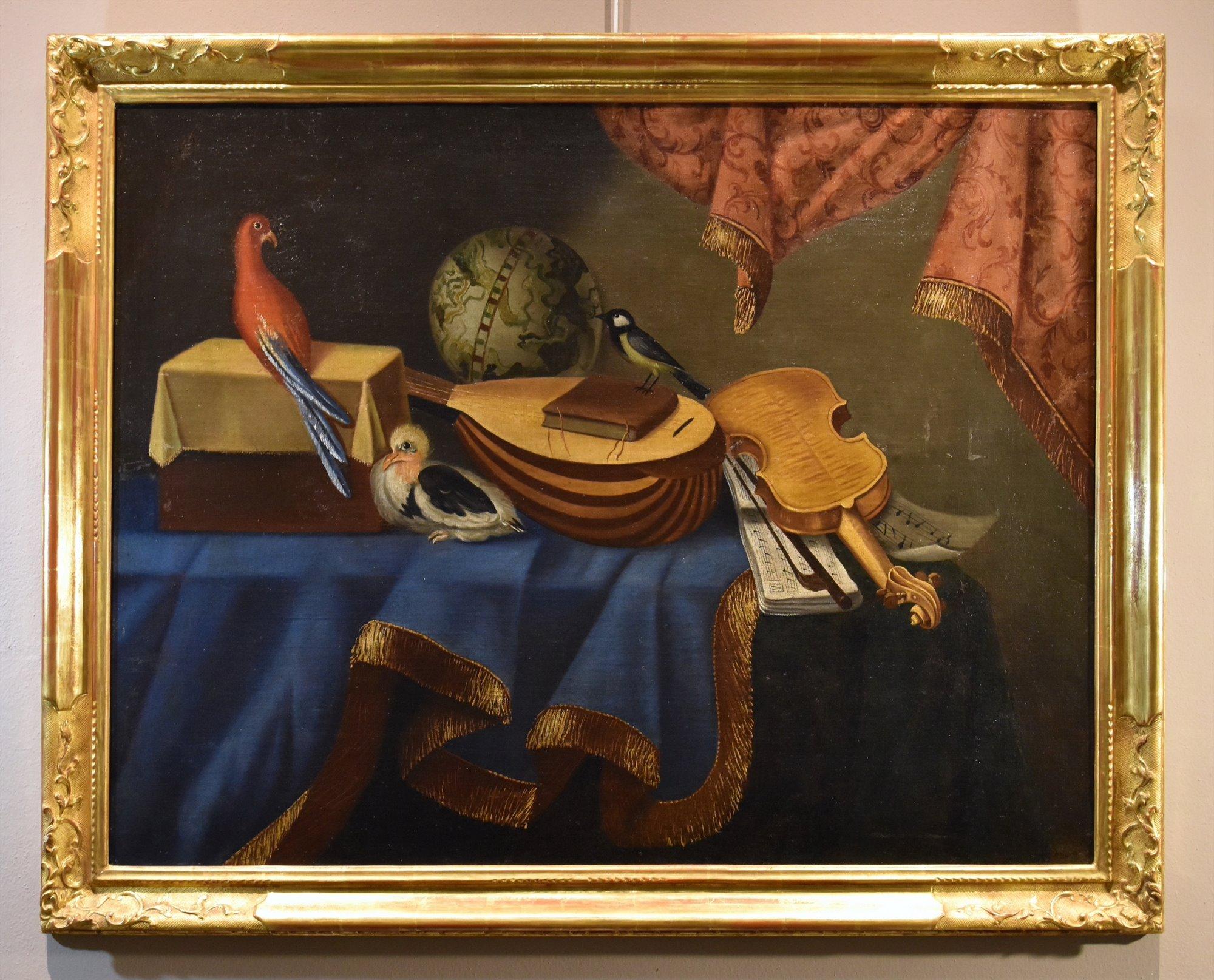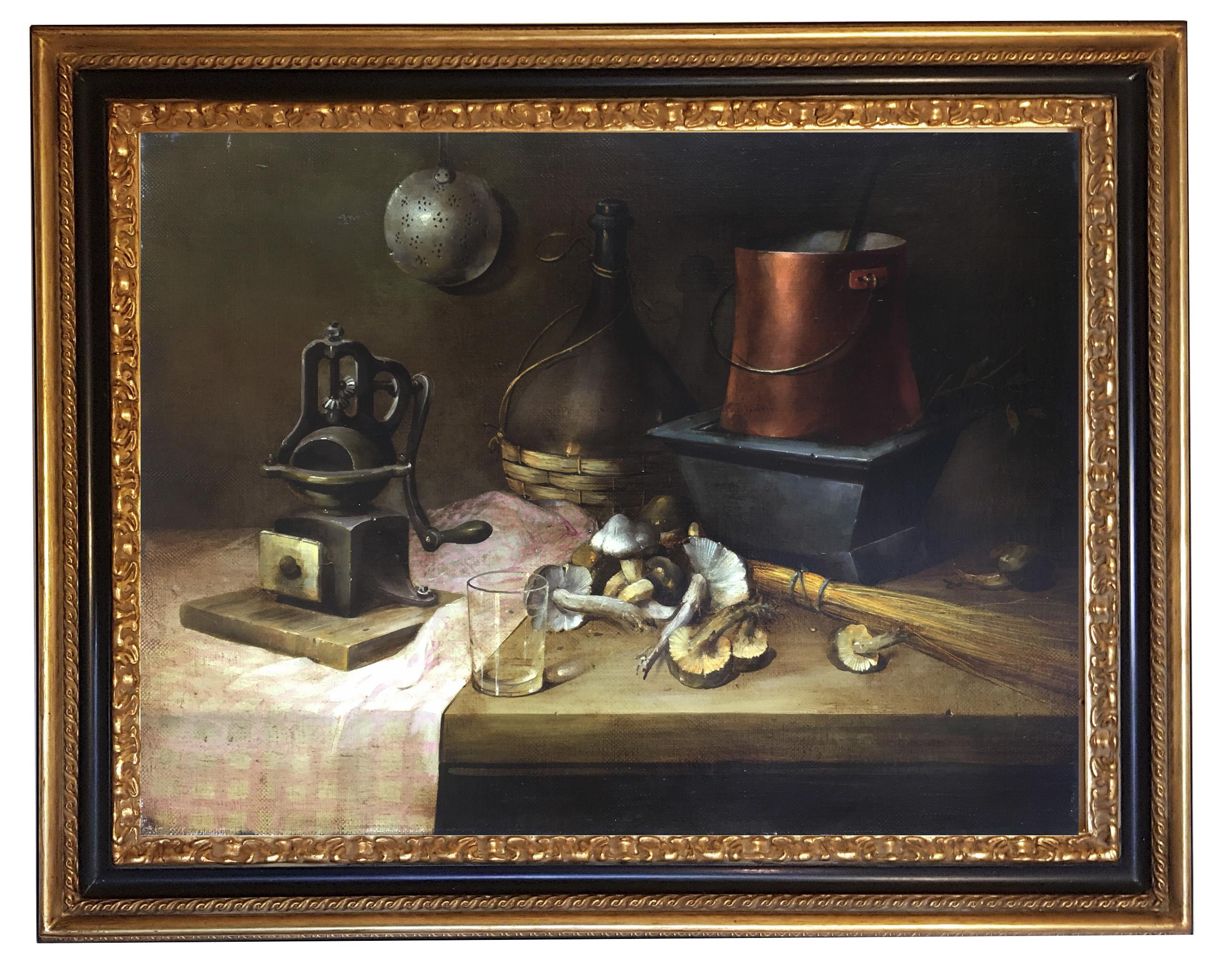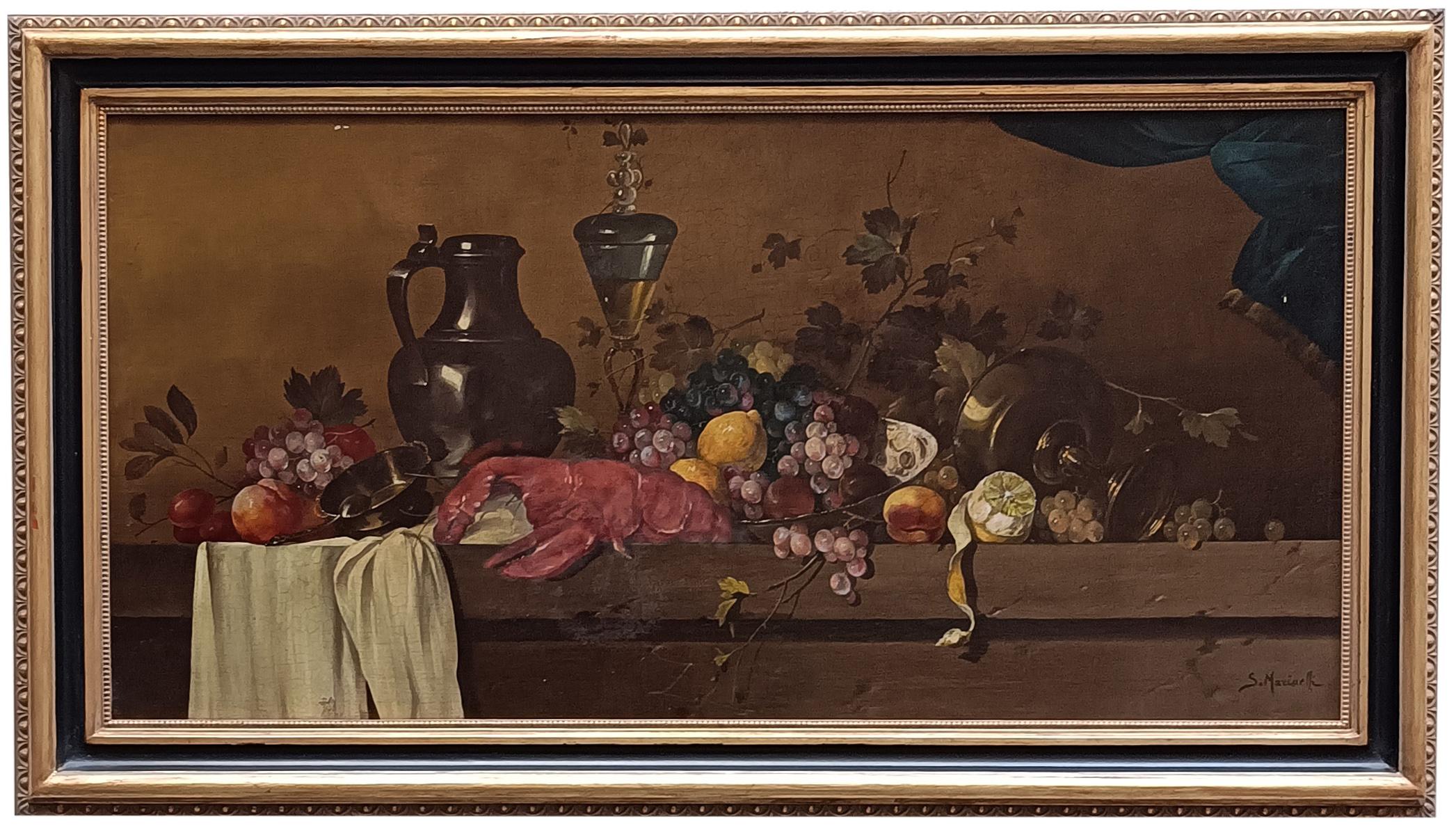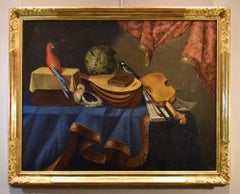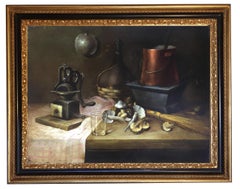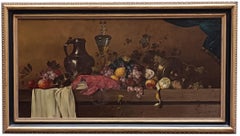Items Similar to Still Life Musical Instruments Bettera Paint 17/18rt Century Oil on canvas Art
Want more images or videos?
Request additional images or videos from the seller
1 of 13
Still Life Musical Instruments Bettera Paint 17/18rt Century Oil on canvas Art1680-1718
1680-1718
$12,082.05
$15,102.5620% Off
£9,048.52
£11,310.6520% Off
€10,192
€12,74020% Off
CA$16,936.01
CA$21,170.0120% Off
A$18,659.54
A$23,324.4220% Off
CHF 9,659.31
CHF 12,074.1320% Off
MX$224,665.66
MX$280,832.0720% Off
NOK 122,310.18
NOK 152,887.7320% Off
SEK 114,902.68
SEK 143,628.3520% Off
DKK 77,624.73
DKK 97,030.9220% Off
About the Item
Bonaventura Bettera (Bergamo, 1663 - documented until 1718)
Still Life with Musical Instruments (LINK)
Oil on canvas
90 x 116 cm - Framed 105 x 131 cm.
The merit of the 17th century Bergamasque school of painting is to have ‘invented’ a type of still life, almost exclusively of musical instruments, that was as successful with the collectors of the time as it continues to be with critics and the modern market.
Alongside the dominant figure of Evaristo Baschenis, the great initiator of this pictorial strand, was Bartolomeo Bettera, who had the ability to seize the inheritance but still forged his own identity, with his own pictorial characteristics.
Our beautiful canvas is to be placed precisely in the sphere of this second great painter, and in particular is attributable to the hand of his son, Bonaventura Bettera (Bergamo, 1663 - documented until 1718), and illustrates, according to a scenography dear to the artist, the usual display of musical instruments lying on a surface covered by an elegant draped carpet and framed by a curtain with golden motifs descending from above.
This attribution is corroborated by a comparison with two signed canvases by Bonaventura, around which the painter's, albeit meagre, body of work has been reconstructed: the first is dated 1718 and comes from Palazzo Passi in Bergamo (now in La Spezia, private collection), the second was originally painted for Palazzo Greppi in Milan (now in a private collection in Bergamo) (1).
(1) For both paintings see most recently A. Morandotti, Bonaventura Bettera, in La natura morta in Italia , edited by F. Porzio, 2 vols., Milan 1989, I, p. 278, fig. 324 and p. 275, fig. 325.
It should be borne in mind that many paintings on the art market have often been attributed to his father, given the great consonance in style, although a more in-depth analysis could indeed bring them closer to the production of the younger Bettera: in particular, in Bonaventura we can see the transition to an 18th century decorative taste characterised by a marked lightening and cooling of the chromatic tone compared to his father's paintings, together with a strong simplification of details.
This characteristic can precisely be seen in the painting in the Puskin Museum in Moscow (2), where we see the young Bettera, who, starting from a phase of strict adherence to his father's models, declines them through a brighter register and the adoption of celestial and pastel tones.
Returning to the details of our work, and to its pendant, we thus find all the elements of the Bergamasque still life, with the display of objects and musical instruments, such as musical scores, violin, lute, viola, all arranged on a table placed in an asymmetrical position with respect to the proportions of the canvas and accompanied by a worked carpet; in addition, we can see other objects, such as a globe, a casket, a book, and various animals, all typical details of the Bettera workshop.
There are no human figures, but musical instruments left there, inanimate objects, seemingly randomly arranged, as if abandoned, some upturned, on top of others; there is even a layer of dust, next to the musical manuscripts.
By way of comparison, we illustrate below a roundup of works that might be similar to ours, in terms of scenic import and style of composition.
ADDITIONAL INFORMATION:
The painting is sold complete with a nice gilded frame and comes with a certificate of guarantee and authenticity.
We take care of and organise the transport of the purchased works, both for Italy and abroad, through professional, tracked and insured carriers.
Should you have the desire to see this or other works in person, we will be happy to welcome you to our new gallery in Riva del Garda, Viale Giuseppe Canella 18. We are waiting for you!
Contact us for any information or to arrange a visit, we will be happy to answer you.
- Attributed to:Bonaventura Bettera (bergamo 1663 - Documented Until 1718)
- Creation Year:1680-1718
- Dimensions:Height: 41.34 in (105 cm)Width: 51.58 in (131 cm)
- Medium:
- Movement & Style:
- Period:
- Condition:
- Gallery Location:Riva del Garda, IT
- Reference Number:1stDibs: LU988115154472
About the Seller
4.9
Platinum Seller
Premium sellers with a 4.7+ rating and 24-hour response times
Established in 2017
1stDibs seller since 2018
264 sales on 1stDibs
Typical response time: 2 hours
- ShippingRetrieving quote...Shipping from: Riva del Garda, Italy
- Return Policy
Authenticity Guarantee
In the unlikely event there’s an issue with an item’s authenticity, contact us within 1 year for a full refund. DetailsMoney-Back Guarantee
If your item is not as described, is damaged in transit, or does not arrive, contact us within 7 days for a full refund. Details24-Hour Cancellation
You have a 24-hour grace period in which to reconsider your purchase, with no questions asked.Vetted Professional Sellers
Our world-class sellers must adhere to strict standards for service and quality, maintaining the integrity of our listings.Price-Match Guarantee
If you find that a seller listed the same item for a lower price elsewhere, we’ll match it.Trusted Global Delivery
Our best-in-class carrier network provides specialized shipping options worldwide, including custom delivery.More From This Seller
View AllStill Life Musical Instruments Bettera Paint 17/18rt Century Oil on canvas Art
Located in Riva del Garda, IT
Bonaventura Bettera (Bergamo, 1663 - documented until 1718)
Still Life with Musical Instruments (LINK)
Oil on canvas
90 x 116 cm - Framed 105 x 131 cm.
The pendenat of this paintin...
Category
17th Century Old Masters Paintings
Materials
Oil
$12,082 Sale Price
20% Off
Still Life Vanitas Noletti Paint Oil on canvas Old master 17th Century Italian
Located in Riva del Garda, IT
Francesco Noletti known as the Maltese (Malta 1611-Rome 1654) Workshop/circle of
Still life with musical instruments, toys, armour, textiles and precious objects
Oil on canvas (52 x 78 cm. - in frame 71 x 102)
This painting, of beautiful scenic effect, depicts a still life composed of a rich display of precious objects, arranged with an apparent disorder, one part on a table and the other on the floor, all theatrically behind a hanging drape from which tassels swing.
Among the objects, our author has reproduced we can see parts of a parade armour with gold borders, jugs and plates...
Category
17th Century Old Masters Paintings
Materials
Oil
$9,493 Sale Price
20% Off
Still Life Italian School 19th Century Paint Oil on canvas Italy Art Quality
Located in Riva del Garda, IT
Still life with vase of flowers
Italian School of the nineteenth century
Oil on canvas
cm. 74 x 92,5
frame 97 x 112
Beautiful painting representing a rich still life, of great deco...
Category
Mid-19th Century Romantic Paintings
Materials
Oil
Still Life Flowers Nani 18th Century Paint Oil on canvas Old master Naples Italy
Located in Riva del Garda, IT
Giacomo Nani (Porto Ercole 1698 - Naples 1770)
Still life with flowers, riser with crystals and liqueurs, icebox, china and basket with biscuits
(LINK)
Oil on canvas
cm. 64 x 73 - Framed cm. 83 x 93
Provenance (see images):
- Dorotheum (April 14, 2005) Vienna, Lot 37
Est: €20,000 EUR - €30,000 EUR
- Dorotheum (October 15, 2008), Lot 281
East: €18,000 EUR - €25,000 EUR
The proposed painting is a work by the Neapolitan painter Giacomo Nani (Porto Ercole 1698 - Naples 1770) and delights us with a selection of his favourite elements in the creation of his precious still lifes; On a stone shelf, on which an embroidered carpet is laid, we see a series of objects, including two painted porcelain cups, a riser with two liqueur bottles and crystal goblets; then there is a transparent glass vase filled with flowers, and finally some foodstuffs, a basket with biscuits, a wrapped Neapolitan aubergine and an icebox with an oyster.
Everything is arranged to create a refined and elegant ensemble.
A pupil of Gaspare Lopez (Naples - Venice ca. 1732), one of the leading generalists of the time, Giacomo Nani developed an autonomous personality over time, much appreciated by 18th century nobles and collectors, including the Duchess of Terranova and the Duke of Limatola, as well as the Bourbons.
Numerous in particular were his paintings owned by King Charles of Bourbon, which are now preserved in Naples and Caserta at the picture gallery of the Royal Estate of Carditello.
Twenty-four canvases by Giacomo Nani were sent to Spain by Charles of Bourbon as gifts for his mother, Elisabeth Farnese, and are today kept at the Royal Palace of Riofrío, one of the residences of the Spanish royal family, and at the Royal Palace of the Granja de San Ildefonso, in Segovia.
A painter of still lifes, his works were often devoted to a wide variety of foodstuffs. In his compositions, foodstuffs of the period appear and, in particular, in the series conserved in Spain, most of the dishes that were served on the tables of the Neapolitans in those years are depicted as in a select menu.
He sometimes depicted objects typical of Neapolitan tradition, as in the present painting, the typical rosolio wine, Capodimonte ceramics...
Category
18th Century Old Masters Paintings
Materials
Oil
$16,643 Sale Price
20% Off
Still Life Adriaenssen Paint 17th Century Oil on canvas Old master Flemish
Located in Riva del Garda, IT
Alexander (Van) Adriaenssen (Antwerp, 1587 - 1661)
Still life with oysters, fish and lobsters
Oil on canvas (67 x 110 cm - In frame 87 x 131 cm)
Expertise by Prof Massimo Pir...
Category
17th Century Old Masters Paintings
Materials
Oil
$16,643 Sale Price
20% Off
Still-Life Flower Von Tamm 17/18th Century Paint Oil on canvas Old master Italy
Located in Riva del Garda, IT
Franz Werner Von Tamm known as Monsieur Daparait (Hamburg 1658-Vienna 1754) Attributed to
Still life of fruit with lizard
Oil on canvas,
58 x 74 cm.
Framed 76 x 92 cm.
This magnifi...
Category
Early 17th Century Old Masters Paintings
Materials
Oil
$8,506 Sale Price
20% Off
You May Also Like
STILL LIFE - Salvatore Marinelli - Oil on Canvas Italian Painting
By Salvatore Marinelli
Located in Napoli, IT
Still life - Salvatore Marinelli Italia 2010 - Oil on canvas cm.70x100
Salvatore Marinelli's painting is inspired by the painting by Anne Vallayer-Coster French painter. Music score painting is a rare type of painting that represents a musical work in the form of a score. It is present in all eras and in many pictorial schools. The use of musical notation, in painting, is appropriate in paintings with...
Category
2010s French School Still-life Paintings
Materials
Canvas, Oil
STILL LIFE - Massimo Reggiani - Oil on Canvas Italian Painting
By Massimo Reggiani
Located in Napoli, IT
STILL LIFE - Oil on canvas cm. 40x50 by Massimo Reggiani, Italy 2005
Still life, a pictorial representation of foodstuffs, objects or inanimate objects, was one of the artistic genres that became completely independent in the seventeenth century. Reggiani has composed this still life inspired by the Dutch school. Fruit, grapes and peaches...
Category
21st Century and Contemporary Old Masters Still-life Paintings
Materials
Canvas, Oil
Still Life - Salvatore Marinelli Oil on Canvas Italian Painting
By Salvatore Marinelli
Located in Napoli, IT
STILL LIFE - Oil on canvas cm.60x80 by Salvatore Marinelli, Italy 2002
Frame available on request from our workshop.
Category
21st Century and Contemporary Old Masters Still-life Paintings
Materials
Canvas, Oil
STILL LIFE - Salvatore Marinelli School Baroque - Oil on Canvas Italian Painting
By Salvatore Marinelli
Located in Napoli, IT
Still life - Salvatore Marinelli Italia 2008 - Oil on canvas cm. 60x120
Salvatore Marinelli's canvas is a painting inspired by Abraham van Beyeren Dutch painter, of the Baroque age, ...
Category
Early 2000s Old Masters Still-life Paintings
Materials
Canvas, Oil
STILL LIFE - Giovanni Bonetti - Still Life Oil on Canvas Painting
By Giovanni Bonetti
Located in Napoli, IT
Still life - Oil on canvas cm.80x100, Giovanni Bonetti, Italy 2003
In this very precious oil on canvas, Giovanni Bonetti is inspired by the XVIII flowery compositions painted by the...
Category
Early 2000s Dutch School Still-life Paintings
Materials
Canvas, Oil
STILL LIFE - Dutch School -Italian Oil on Canvas Painting
By Giovanni Perna
Located in Napoli, IT
Still life - Giovanni Perna Italia 2004 - Oil on canvas cm.50x70
in this beautiful oil on canvas Giovanni Perna was inspired by the paintings of the Spanish painter of Dutch origin J...
Category
Early 2000s Dutch School Still-life Paintings
Materials
Canvas, Oil
More Ways To Browse
Antique Document
Antique Musical Instrument
Antique Violins
Antique Lute
Natura Morta
Antique Viola
Musical Figures
Oil Paintings 17 Century
Painting Musical Instruments
Framing Antique Documents
Framed Boat Paintings
Naive Art
Century Girl Vintage
French Culture
12 X 12 Art Flower Painting
Salmagundi Club
20th Century Portrait Of A Lady
20th Century Paris Street Scenes
